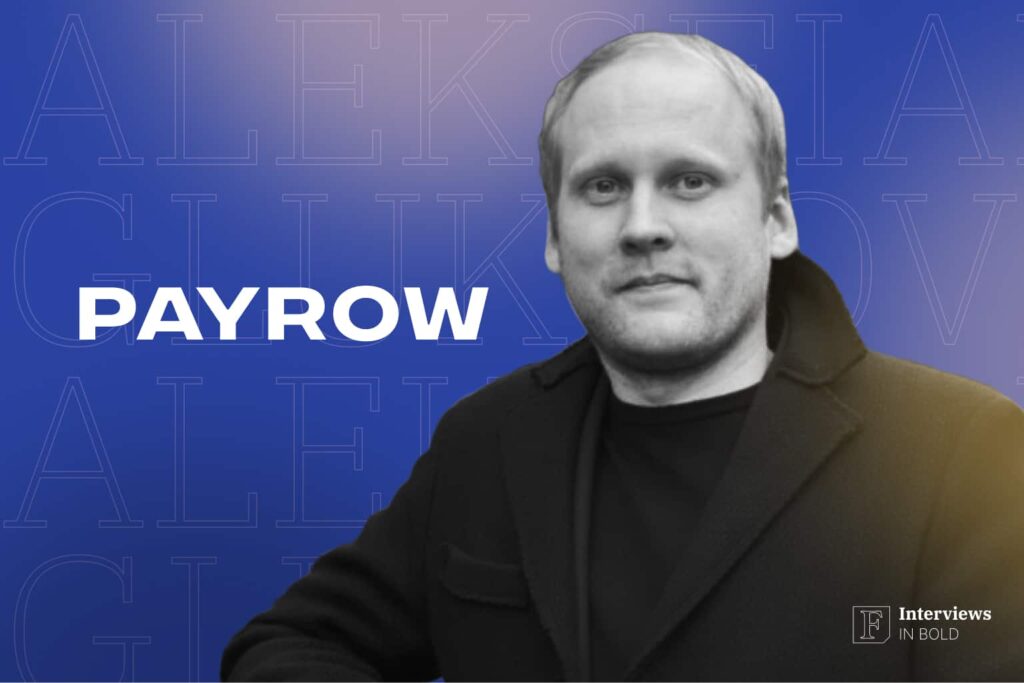We were delighted to have the opportunity to speak with Aleksei Glukhov, co-founder and product owner of the British FinTech company Payrow. In this insightful conversation, Aleksei delves into the factors driving the transformation in software development, the sustainability of these changes, and the significant impact on market dynamics and product development.
The excitement around LLM, no-code, and low-code technologies is palpable, especially regarding their potential to transform software development for startups and Minimum Viable Products (MVPs). What are your thoughts on this trend?
We are on the brink of a massive surge in software creation. The traditionally high costs associated with software development have been largely driven by the significant salaries commanded by skilled software engineers. With the advent of LLM, no-code, and low-code technologies, these barriers are being dismantled, making software production more accessible and affordable for startups and those working on MVPs.
How do Large Language Models (LLMs) impact software development today? What potential effects could this shift have on software pricing and market dynamics?
LLMs have garnered significant attention for their ability to generate code with surprising proficiency. They are remarkably good at writing code, although not as polished or efficient as that produced by experienced developers. You wouldn’t rely on an LLM to create a custom enterprise-grade software solution just yet. However, LLMs enable individuals with limited technical backgrounds to autonomously create basic functional code snippets. This marks a shift from the traditional belief that software development is exclusively reserved for highly skilled programmers. This capability could significantly alter the cost dynamics of the software itself.
Consumers will only pay for something they cannot create themselves. This democratisation of coding capabilities has the potential to transform software development by empowering a broader audience to innovate and solve problems through code. This shift may lead to a deflationary effect on software prices, especially for generic applications that face competition from user-generated alternatives. However, sectors requiring specialised technical knowledge or acting as critical infrastructure (such as databases or systems of record) may remain relatively insulated from these market forces.
Can you elaborate on the implications for MVPs and market dynamics?
The impact of LLMs on software development is particularly evident in the creation of MVPs. Discussing broader implications, I think that while LLMs may not spell the demise of software itself, they are reshaping expectations around Minimum Viable Products (MVPs). As non-technical users gain the ability to develop rudimentary software solutions independently, there may be a corresponding decrease in demand for off-the-shelf applications. Consumers are increasingly willing to invest in specialised software that offers unique functionalities beyond what they can create themselves.
Additionally, there could be an opportunity to build platforms on which this new LLM-driven code is written, possibly integrating with systems of record or emerging as AI agent platforms that help users orchestrate tasks across existing systems. For an MVP, in my opinion, this is acceptable to quickly assemble, provided you proceed with caution and have a solid grasp of the actual data.
How are no-code and low-code platforms contributing to this transformation?
In parallel with the rise of LLMs, the rise of no-code and low-code platforms further accelerates the democratisation of software development. They empower business users and citizen developers to create functional applications without deep coding knowledge, accelerating time-to-market and fostering innovation within organisations
However, no-code platforms can be risky, as there are potential vulnerabilities and issues with code review. For instance, there’s a concern that tools like ChatGPT might generate subpar results.
A more promising approach is to leverage AI for analysing big data, constructing models based on this analysis, and generating potential alerts. Additionally, using AI to develop predictive models and combat fraud holds significant promise.
What are your thoughts on the future integration of LLMs with no-code and low-code solutions? Could AI completely supersede low-code development in the future?
Looking forward, I envision a convergence where LLM-generated code integrates seamlessly with no-code and low-code platforms. There’s tremendous potential in developing AI agent platforms that orchestrate LLM-generated code across various operational frameworks. Such platforms could enhance organisational agility, allowing businesses to leverage advanced capabilities without extensive technical investments.
While low-code has been a catalyst for accelerating software development, AI will further amplify this acceleration. Although some applications may eventually be developed entirely by AI without human input or low-code tools, it does not mean that all software development will render low-code platforms obsolete. Instead, we may see the rise of a new generation of AI-enhanced low-code platforms, which will dominate the creation, debugging, and maintenance of complex, tailored, and high-stakes applications.
Are new technologies applicable in the financial sector?
They can play a significant role in transforming the realms of finance and payments. Low-code tools and applications often provide a visual, sometimes ‘drag-and-drop’ interface, enabling software development without extensive manual coding. The potential for financial organisation employees to rapidly deploy new systems to seize new revenue opportunities and swiftly comply with evolving regulations is immense.
The Icon Solutions Report, which surveyed senior executives from tier-one banks across Europe and North America, highlights the pressing need for changes in the payment processing sector. A significant potential revenue loss is attributed to the inability to meet product demand swiftly. The primary culprits for this issue are a shortage of developer capacity and other resource constraints, which continue to hinder the progress of ambitious organisations.
Moreover, the report indicates that 55% of tier-one banks favour developing their own payment processing software. This preference stems from a desire to maintain project control and the perception that reliable off-the-shelf solutions are scarce.
What are the risks and challenges of new technologies?
Custom-coded applications often have security vulnerabilities, such as session management issues and input validation errors, making them challenging to secure. Effective security management requires careful planning, yet many startups falter due to poor strategies. I think many users of low-code/no-code (LCNC) platforms rely on these platforms for security features due to a lack of in-house security experts.
I believe that compliance-focused industries, like financial services and healthcare, demand the highest security levels for their applications.
As applications become more integrated with other systems, IT involvement becomes necessary for modifications, integration, and performance testing. This can lead to users losing control over their applications and IT departments facing increased workloads. Establishing guidelines for the use of low-code and no-code applications can help manage these issues by setting clear boundaries and requirements for IT involvement in more complex integrations.
How should businesses navigate these technological shifts?
In conclusion, the synergy between LLMs, no-code, and low-code platforms undoubtedly represents a paradigm shift in software development. However, whether this shift will be beneficial or not remains to be seen. As these technologies evolve, businesses must navigate a landscape of uncertainty, balancing agility and innovation with caution. Historically, disruptive technologies have lowered cost barriers and catalysed transformative shifts across industries, but not without their own set of challenges. The future of software development will likely be shaped by how effectively businesses can integrate and leverage these innovations to drive growth and competitiveness, all while mitigating potential risks.
Read more interviews here.








